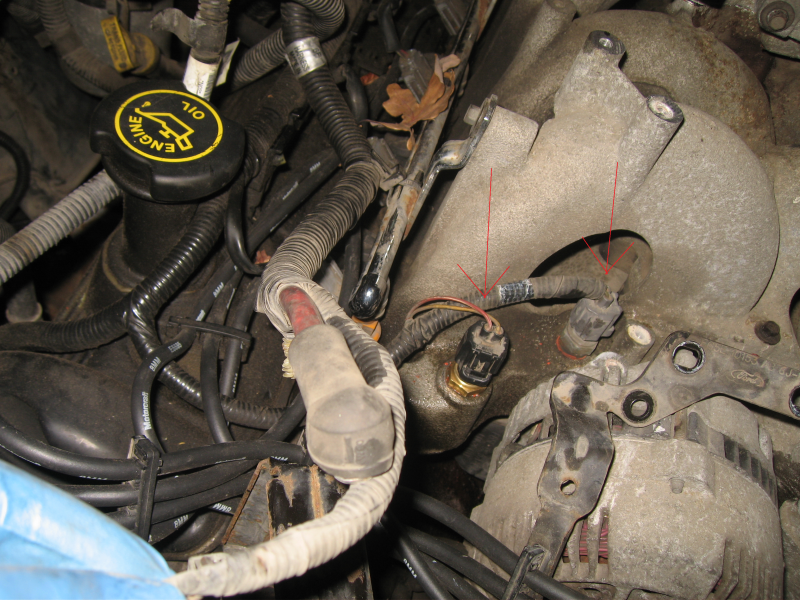

- #5.3 vortec coolant temperature sensor location driver
- #5.3 vortec coolant temperature sensor location manual
Since you need to jack the front end up and will be placing the front end on jack stands, make sure your vehicle in on a flat surface.ĭo not jack up a vehicle on a driveway or incline. Step 1: Make sure vehicle is on a level working area. Make sure you wear safety glasses and gloves to protect your hands from hot coolant if the engine is not cold. Since you'll be underneath the car and the potential of coolant hitting your face is high, it may be a good idea to wear a safety shield to protect your face. Tip: This job should only be completed when the engine is cold and has not been running for a minimum of one hour.
#5.3 vortec coolant temperature sensor location manual
However, since all vehicles are unique, it's important to verify specific instructions with your vehicle’s manufacturer’s service manual before proceeding. Note: The process of removing the coolant temperature sensor is very consistent, regardless of the type of vehicle you own.If you notice coolant in front of the motor, it may be coming from the engine coolant temperature sensor's location.

If your engine is overheating occasionally, the problem may be with the coolant temperature sensor.Ĭoolant is leaking under the motor: it's also common for the coolant temperature sensor to become loose and cause engine coolant to leak from under the motor. If this occurs, the potential of overheating becomes greater. The engine is overheating: on the reverse side, sometimes the sensor will fail entirely and won't be able to monitor the engine's coolant temperature. The result will be more black smoke being expelled from the exhaust port of the cylinder head and out the tail pipe. When the fuel mixture is rich (meaning more fuel than air in the vapor inside the combustion chamber) the cylinder will not be able to burn all the fuel. If you notice that your temperature warning light is on and the fuel mileage is really poor, it may be caused by the sensor.īlack smoke from the exhaust: another side effect of a rich engine is that black smoke (or unburnt carbon from fuel) will be present from the vehicle's exhaust when you accelerate. The side effect of this reaction is that the fuel economy will drastically be cut. This in turn triggers the ECM to either add more fuel or reduce air mixture to create a “rich” situation, designed to cool the cylinders and reduce the potential of overheating. The engine is getting poor fuel economy: when the coolant temperature sensor is not functioning correctly, it tends to relay false information to the engine control module. Noted below are a few of the warning signs that will alert you that the coolant temperature sensor is damaged and needs to be replaced. Before you make the decision to replace the coolant temperature sensor, make sure diagnose some of the warning signs of a faulty coolant temperature sensor. Taking time to properly diagnose the precise cause of the overheating situation is very important to providing a solution and actually fixing what is broken. When a problem occurs with engine heating or overheating, it may be due to one or multiple broken parts. The coolant system on today's cars, trucks, and SUV's is comprised of multiple components that work together to keep your engine running well. Part 1 of 3: Diagnosing a problem with the coolant temperature sensor If you discover that the sensor is failing, you'll have to replace this device by following the step-by-step instructions noted below. When the signal is sent to the ECM, the computer adjusts the vehicles ignition timing, fuel flow, and other factors that trim or enhance performance based on the coolant temperature.ĭue to the fact that engine temperature plays a vital role in the overall performance of any vehicle, having a properly functioning coolant temperature sensor is essential. The coolant temperature sensor (switch) utilizes electrical resistance to measure the coolant's temperature.
#5.3 vortec coolant temperature sensor location driver
When the sensor is functioning properly, it will tell your on board computer if the temperature is too high, alerting the driver that a problem exists by illuminating a warning light on the dashboard. The coolant temperature sensor, also known as the coolant temperature switch, is the engine management system that monitors the temperature of the coolant and relays this information to the ECM. One of the most important systems to monitor is the cooling system, which includes the radiator, water pump, radiator fan, coolant lines, and overflow tank. Today's engines monitor virtually every function to ensure your vehicle runs strongly and efficiently every day.


 0 kommentar(er)
0 kommentar(er)
